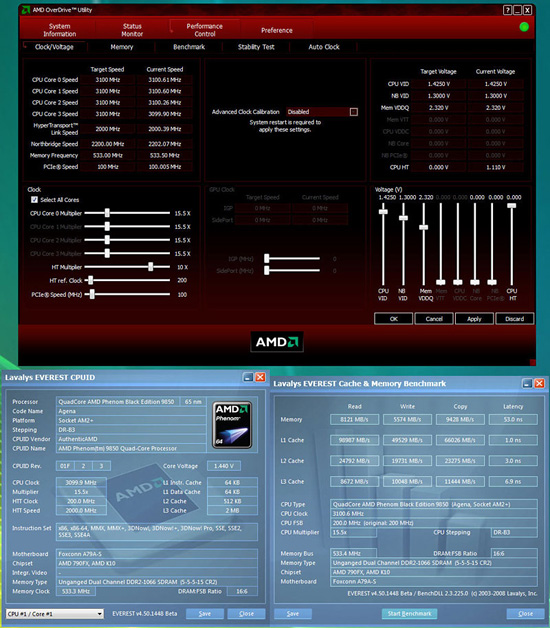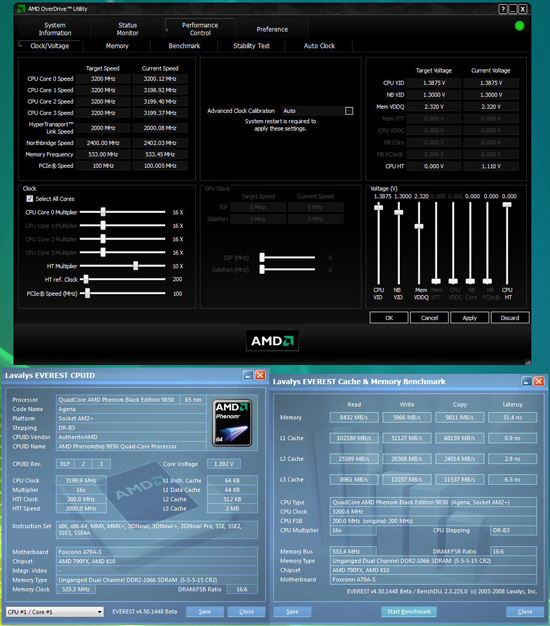AMD SB750 arrives on the Foxconn A79A-S...
by Gary Key on July 21, 2008 3:00 AM EST- Posted in
- Gary's First Looks
(7/22/08 update - We are still clarifying ACC details with AMD before we publish the full article this week)
Our first AMD SB750 equipped motherboard arrived this weekend courtesy of Foxconn. We have been working around the clock to dispel or verify the rumors about how a simple update to the SB700 SouthBridge could unlock the overclocking potential of the Phenom processor series. It turns out changes to the SB750 are actually significant and include a new low level link interface that AMD has named Advanced Clock Calibration. Along with the new ACC technology is a significant update to the AMD Overdrive Utility and required BIOS code changes for this new interface to operate properly.
In fact, there are so many changes that we will be back tomorrow with a full review of this new SouthBridge, the technology behind it, and an in-depth look at AOD version 2.1.2. Also, we will provide performance results from a few different Phenom processors to indicate what works well and what does not when utilizing ACC. With that in mind, our sneak peak today will not fully dispel or verify the performance rumors. Instead, we think our initial test results should provide a clue as to the potential of this new technology. To be blunt, our initial results were not that impressive but after a BIOS update, a day of tweaking and some conversations with AMD, our opinion is starting to change quickly based on the following results.
 |
This particular 9850BE required 1.425V to reach 3.1GHz with a NorthBridge clock of 2.2GHz. This was basically our limit on a variety of AM2+ boards and it did not matter whether we increased voltages, decreased NB clocks, or chose a 2GB memory configuration under Vista 32, the CPU just was not stable at most settings above 3.1GHz. As a side note, we are running 4GB of GSkill DDR2-1066 memory at 1.90V under Vista 64 for these tests. Now that we have our baseline, we turned ACC on in the AOD control panel using auto settings (also available in the BIOS) and rebooted.
 |
After a few tweaks and reboots, we reduced our core voltage from 1.4250V to 1.3875V, increased our NB speed from 2.2GHz to 2.4GHz, and changed our clock multiplier from 15.5 to 16 giving us a 3.2GHz core clock speed. This is an instant 100MHz increase in core speed while decreasing core voltages by 3%, increasing NB clock speed by 9%, and improving memory latencies up to 6% (all important L3 cache). These results were completed with ACC on set and forget auto settings.
We have reached 3.3GHz on this CPU with further tuning of system settings including individual core tuning with ACC. While our initial 100MHz speed increase may not sound impressive, we must consider the fact that this CPU was right on the ragged edge of stability at 3.1GHz. We are now able to run higher NB clock speeds and higher core clock speeds at lower voltages while maintaining a fair amount of headroom for further performance improvements. Even more impressive (results tomorrow) is that fact that this CPU will now clock to 3GHz on stock voltages instead of 2.7GHz before tuning with ACC.
Our last screen shot shows what is possible with ACC and the new AOD improvements when focusing on improving memory performance with minimal core clock increases. Our goal was to find optimal system performance with the 9950BE while decreasing system voltages below normal standards to keep thermals in tact.
 |
We will be back shortly with additional results and an overview of AMD's new SB750 SouthBridge and ACC technology, until then, start saving your pennies if you are an AMD enthusiast.










38 Comments
View All Comments
quanta - Friday, July 25, 2008 - link
If you are going to buy the SB750 boards, you should stay away from Foxconn, because it was recently busted for deliberate sabotaging alternative systems and making shoddy motherboards that are not ACPI-compliant.[1] As strange as it sound, it was Microsoft Certified Motherboard! If that's not enough, currently the company is rated F by Better Business Bureau![2] If you want a reliable computer, stay away from the con that is Foxconn![1] http://ubuntu-virginia.ubuntuforums.org/showthread...
[2] http://www.labbb.org/BBBWeb/Forms/Business/Company...">http://www.labbb.org/BBBWeb/Forms/Busin...age_Expo...
BLaber - Wednesday, July 23, 2008 - link
I agree to an extent that improved super pi results don't guarantee performance improvements across the board , but 15% improvement is not totally because of cache size getting bigger , there has to be some thing else with the combination of improved cache size like decreased cache latency , improvement in core e.t.c to resulting in improved pi results....Any way time will tell ... hope fully thing will get better for AMD , Bcz without AMD we are pretty much screwed by Intel.
geok1ng - Wednesday, July 23, 2008 - link
AMD is in dire straits on the CPU market for sure, but they are in better position on the Graphics and HTPC market with the 4000 series and the 780G.i dont think that 45nm Phenoms can save the company, by the time 45nm parts arrive Intel will be all over the Nehalem, with DDR3 prices plummeting due to scaling gains. It is a very long shot to infere that 45nm Phenoms can compete with 45nm C2Ds, since these CPUs will reach sub $200 price tags by the time 45nm arrive.
But if AMD can put SB750 on the shelfes right now they may take advantage of the good moment they are living on the graphics market:
a- bundle 4850/4870/4870X2 with mobos/CPUs, since SB750 allows Phenoms to reach 3Ghz+ clocks, taking triple and quad cores to " budget gaming". These systems will dominate the price/performance budget gaming market, since the "budget" quad offer from intel (q6600/Q9450) rarely reachs 3,6ghz on air
b-created HTPCs mobos that can handle triple and quad cores Phenoms and take advantage of the lower power consumption that the SB750 allows, since the only reason to go Intel in a HTPC is the raw performance of C2Ds, something that 3 or 4 cores at 3Ghz+ may confront in equal terms.
Lets use my situation as an example: i WILL have a 4870X2, the very first VGA to allow gaming at 2560x1600, my 30" resolution. I can:
a-Put the 4870X2 on my 18 months old E4300+P5WDH system and wait for Nehalem to build a new system.
b-Dump $300 on a X48/P45 DDR2 mobo and $215 on a E8400
c-Build a quad phenom+SB750 system. But this latter option implies that SB750 will be available at 4870X2 launch and that triple/quad Phenoms prices go lower, right now they cant even compete with the higher performing/2 years old Q6600!
Maybe it is past time for AMD to take the gloves off on the IGP front:
Build an IGP that can allow gaming at 1680x1050/0xAA (the 780G can be overcloked enough to allow gaming at 1280x1024/0xAA) and make all the competitors on the HTPC AND the budget gaming markets run away!
Such a system would convince people that a Phenom may be less powerful than a Core 2, but it runs in a more complete plataform. Thas was the reasoning that carved AMDs market share on the HTPC market with the 780G, why cant it be the reasoning that will dominate the budget/casual gaming market once and for all?!
BPB - Wednesday, July 23, 2008 - link
You can put an E8400 in the P5W DH board, I have the P5W DH Deluxe and am considering doing just that.wingless - Wednesday, July 23, 2008 - link
You make several excellent points. I would like to point out to you that 45nm Denebs are at least 12.5% faster than current Phenoms according to the SuperPi results published a couple of weeks ago. Also remember that K10 architecture historically does very poorly in SuperPi so some analysts suggested that the 12.5% increase is like a worst case scenario for Deneb. PCPer analysts said they have heard from people that have tested K10.5 that it performs between 20 and 30% better than current 65nm Phenoms. Deneb will apparently have much higher IPC according to those results and will comfortably match or exceed Penryn. The only problem on AMD's side is timing. They need to get this "fixed" K10.5 out the door ASAP but it won't arrive until early Q4/2008. Hopefully their Chipset and GPU business will keep them afloat until Deneb hits the market but it will be tight.BitByBit - Saturday, July 26, 2008 - link
A boost of 20-30% would require a complete architectural overhaul, so I would take such claims with a generous pinch of salt. I expect around a 5% boost from the additional cache (application dependent) and another 5% from core tweaks, giving an average gain of a little over 10%, maybe more in certain apps.Martimus - Wednesday, July 23, 2008 - link
One problem with that is that SuperPI is heavily reliant on cache, and Deneb has 3 times the L3 cache that current Phenom has. So using those results to say that Deneb is 15% faster isn't exactly an apples to apples comparison. It may very well have less of a performance increase with other applications.spidey81 - Wednesday, July 23, 2008 - link
From what I'm reading here, does it seem reasonable to assume that future higher clocked Phenoms will not be compatible with older 790FX/SB600 boards? I recently went with the 790FX board because from all the road maps that I had seen, AMD was going to make it's near future processors compatible with the socket. And therefore make an easier upgrade path. Does anyone have any insight into this?Darkskypoet - Tuesday, July 22, 2008 - link
Been waiting for the remainder of the review all day... Issues, troubles, or just teasing?ZootyGray - Tuesday, July 22, 2008 - link
At the top of the page:"(7/22/08 update - We are still clarifying ACC details with AMD before we publish the full article this week)"
This is like waiting for my favourite cappucino frozen yogurt in a cone. :)
Take your time, Gary - I appreciate the facts more than the hype. Do what you gotta do.
I love this - talking to AMD - I feel really 'connected'.